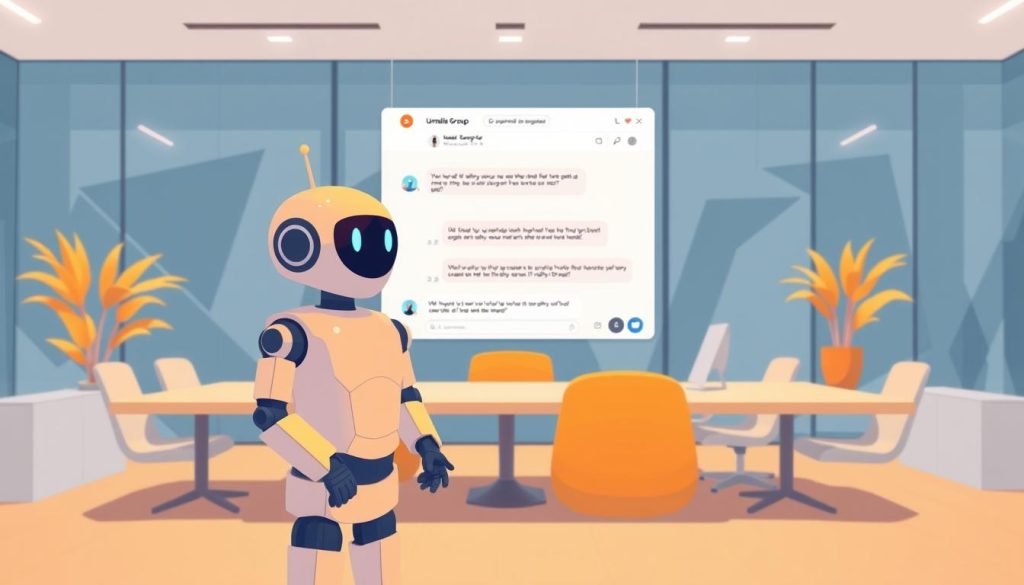Imagine a business tool so effective that 80% of users report a positive experience. This isn’t a distant dream. It’s the reality for companies using intelligent conversational solutions today.
The global market for these AI assistants was valued at a staggering $5.1 billion in 2022. Experts project it will grow by 23.3% annually through 2030. This explosive growth shows a massive shift in how businesses operate.
Sectors like retail, healthcare, and finance are leading the charge. They are using this technology to create meaningful engagement. The goal is to meet modern customer expectations for instant, helpful service.
In fact, 72% of business leaders now prioritize expanding their AI integration. They see it as essential for staying competitive and improving efficiency. This guide will show you how to harness this power for your organization.
Table of Contents
Key Takeaways
- The market for AI conversational tools is experiencing massive, multi-billion dollar growth.
- A vast majority of customers have positive interactions with these automated systems.
- Business leaders across industries are prioritizing this technology to enhance service.
- Successful deployment addresses real challenges while boosting operational efficiency.
- Strategic integration is key to creating valuable and lasting customer relationships.
The Evolution and Impact of AI Chatbots
What began as simple question-and-answer programs has evolved into sophisticated artificial intelligence that learns from every interaction. This transformation represents a fundamental shift in how businesses approach customer communication.
Shifting from Traditional to AI-Powered Tools
Early automated systems operated on rigid rules. They could only respond to specific commands. Customers often found them frustrating when questions varied from expected patterns.
Modern solutions use natural language processing. They understand context and intent. This allows for more natural, helpful conversations.
| Feature | Traditional Systems | AI-Powered Solutions |
|---|---|---|
| Learning Ability | Static, rule-based | Adaptive, learns from interactions |
| Response Flexibility | Limited to predefined answers | Contextual, understands variations |
| Complex Question Handling | Basic queries only | Multi-step problem solving |
| Best Use Case | Short-term campaigns | Long-term customer communication |
Improving Customer Engagement and Efficiency
Intelligent assistants provide instant responses any time of day. They handle complex questions that previously required human intervention. This improves both service quality and operational efficiency.
« The shift to AI-powered communication tools represents more than technological advancement—it’s a complete reimagining of customer relationships. »
Businesses see significant reductions in response time. They maintain consistent service across time zones. This level of online communication was unimaginable just a few years ago.
The impact extends beyond immediate customer service. These tools gather valuable insights from every interaction. They help businesses understand customer needs more deeply.
Understanding Chatbot Implementation

At their core, these intelligent assistants are powered by sophisticated AI that learns and adapts from every conversation. They understand human language and provide helpful responses.
Defining AI Chatbots and Their Capabilities
Modern systems use three key technologies to understand you. Natural Language Processing (NLP) breaks down sentences to grasp meaning. Machine Learning (ML) helps them get smarter over time by learning from data.
Deep Learning models, like GPT, analyze entire conversations at once. This allows for responses that feel natural and stay on topic.
| AI Technology | Primary Function | Result for the User |
|---|---|---|
| Natural Language Processing (NLP) | Analyzes sentence structure and intent | Understands varied questions |
| Machine Learning (ML) | Learns from past interactions | Improves answer accuracy |
| Deep Learning (e.g., GPT) | Processes context from entire text | Delivers human-like conversation |
How Chatbot Implementation Transforms Business Processes
Integrating this technology reshapes how a company operates. It automates routine tasks like answering common support questions. This frees up staff to handle more complex issues.
The system can qualify leads and gather valuable user data 24/7. This leads to more efficient business processes and happier customers. A successful setup enhances human efforts, as seen in cases of enhancing business tools.
You get instant, consistent service across all channels. This transformation creates a more responsive and data-driven organization.
Defining Goals and Identifying Business Needs
The foundation of any effective automated communication system lies in clearly defined business goals. Without this crucial first step, even the most advanced technology can fall short of expectations.
Setting Clear Objectives for Customer Support and Lead Generation
Many organizations face overwhelming customer service volumes. This leads to frustrating wait times and missed opportunities. An intelligent assistant can transform this challenge into a strategic advantage.
Common motivations include reducing support volume by 20% or achieving a 15% conversion rate in chat interactions. These specific targets provide clear direction for your project’s success.
Automated lead qualification helps overcome underperforming landing pages. It generates valuable contacts around the clock. This approach serves multiple business objectives simultaneously.
Evaluating Expected ROI and Performance Metrics
Calculating return on investment starts with understanding current costs. Determine how much each customer service interaction expenses your company. Then estimate how many repetitive questions could be automated.
Track meaningful performance metrics beyond simple conversation counts. Focus on resolution rates, customer satisfaction scores, and conversion rates. These indicators reveal true business impact.
The system gathers valuable information from every interaction. This data helps your company understand what customers really care about. Clear goals and realistic expectations ensure your investment delivers tangible results.
Choosing the Right Tools and Platforms
With so many development options available today, selecting the ideal conversational tool requires careful consideration of your specific needs. The right platform can make your automation journey smooth and successful.
Comparing Popular Chatbot Development Tools
Leading solutions like Google’s Dialogflow offer user-friendly natural language processing. Microsoft Bot Framework provides comprehensive enterprise capabilities. Rasa stands out as a flexible open-source option.
IBM Watson Assistant delivers powerful AI services for complex interactions. No-code platforms like Voiceflow and Botpress have democratized development. They allow teams without extensive programming skills to create effective solutions.
Many providers offer free tiers perfect for small businesses testing the waters. This approach helps manage costs while proving value before larger investments.
Vendor Selection and Onboarding Best Practices
When evaluating platforms, consider integration capabilities with your existing systems. Assess the quality of customer support and specific features your use case requires.
Reputable vendors assign dedicated customer success managers. They guide your team through every step of the process. These experts explain core platform elements and define clear responsibilities.
The right partnership aligns with your company’s technical capabilities. It ensures ongoing support throughout your automation journey. Choosing wisely sets the foundation for long-term success.
Designing Engaging Conversations and User Experience

Every message your digital helper sends reflects your brand’s voice and values to website visitors. The design phase transforms basic exchanges into meaningful interactions that customers genuinely enjoy.
Crafting a Natural, Friendly Conversational Flow
Great conversation design anticipates what users will ask. It provides clear pathways to answers without frustrating repetition. The flow should feel like talking to a helpful colleague.
Choose message formats based on your bot’s purpose. Engaging content works for building relationships. Quick solutions serve customers needing immediate help.
| Bot Purpose | Recommended Format | User Benefit |
|---|---|---|
| Building Engagement | Conversational text with images | Enjoyable, interactive experience |
| Quick Support | Buttons and quick replies | Fast problem resolution |
| Lead Generation | Guided question flows | Streamlined information gathering |
Creating a Brand-Aligned Chatbot Persona
Your automated assistant should represent your company authentically. Choose a name and appearance that matches your corporate identity. This creates consistency across all customer touchpoints.
Practical customization options include designing an avatar with your logo. Select color schemes from your brand guidelines. Develop a conversational tone that feels true to your company’s communication style.
Effective design balances efficiency with personality. It quickly addresses user questions while strengthening your brand connection. This approach turns routine interactions into valuable engagement opportunities.
Training Your AI Chatbot for Success
Proper preparation transforms a basic automated system into a genuinely helpful conversational partner. This phase determines whether your digital assistant will frustrate users or provide valuable support.
Utilizing NLP, ML, and Deep Learning for Better Responses
Natural Language Processing helps your bot understand different ways people ask the same questions. Machine Learning allows it to improve from every interaction over time.
Deep Learning models analyze entire conversations for context. This combination creates responses that feel natural and stay relevant to user needs.
Incorporating Real-World Data and User Inputs
Feed your system with actual customer conversations and industry-specific data. Include both text and speech information to handle diverse input methods.
Training should cover edge cases and synonyms for common queries. A successful chatbot recognizes that « account setup help » and « can’t create profile » mean the same thing.
Continuous training ensures your assistant gets smarter with each user interaction. Regular updates based on conversation reviews keep your chatbots effective long-term.
Integrating APIs and Enhancing Functionality
The true power of your automated assistant emerges when it connects seamlessly with your existing digital tools. This integration transforms a basic conversational bot into a powerful system that operates across your entire ecosystem.
Your solution can pull real-time customer data from CRM platforms. It can check inventory levels from e-commerce systems instantly. This creates a unified experience rather than disconnected responses.
Seamless Integration with CRMs and Social Media Platforms
Connecting to customer relationship management systems allows your agent to access purchase history and preferences. This personalization makes interactions more relevant and helpful.
Social media connectivity is particularly valuable for reaching younger audiences. Over 50% of millennials discover products through these channels. Placing your assistant on Facebook Messenger meets customers where they already engage.
Expanding Features Through Third-Party Services
API connections unlock capabilities beyond basic conversation. Your system can integrate with payment gateways, scheduling tools, and analytics platforms.
This expansion happens through various integration points. Each connection adds specific functionality to enhance your website experience.
| Integration Type | Primary Function | Business Benefit |
|---|---|---|
| CRM Systems | Access customer data and history | Personalized service and support |
| E-commerce Platforms | Check inventory and order status | Accurate real-time information |
| Social Media | Engage customers on familiar channels | Increased reach and discovery |
| Internal Tools | Automate team workflows | Improved operational efficiency |
Choose integration points based on where your customers interact most. Whether through your website widget or social media, strategic connections create a cohesive experience.
Testing and Optimizing for Peak Performance
Testing and optimization separate successful digital assistants from those that frustrate users. This crucial phase ensures your system delivers smooth, helpful interactions from day one.
Conducting Comprehensive Functionality and Usability Tests
Before launch, your team should test every conversation path. Have employees role-play as customers with different questions. Automated scripts can simulate hundreds of user cases simultaneously.
This process identifies response delays and misunderstood intents. Fixing these issues pre-launch prevents customer frustration. Thorough validation builds confidence in your system’s capabilities.
Collecting User Feedback and Analyzing Chatbot Analytics
Once live, track essential metrics that reveal true performance. Focus on these key indicators:
- User engagement rates showing interaction frequency
- Resolution rates measuring independent problem-solving
- Direct feedback scores from satisfaction surveys
Your system should automatically request feedback after interactions. This provides real-time information about what works well. Response time remains critical—75% of consumers consider it the most important factor.
Continuous optimization is an ongoing process. Review conversation data regularly to identify drop-off points. This helps refine responses and add new topics based on actual user needs. A well-tested system becomes a valuable asset for your digital strategy.
Conclusion
When properly executed, intelligent conversational systems become indispensable assets that transform customer interactions and internal workflows. The initial investment of time and resources pays off quickly through enhanced efficiency and consistent support.
Following the systematic steps outlined—from defining clear goals to continuous optimization—ensures your company achieves a successful chatbot implementation. This approach makes the development process manageable for businesses of all sizes.
Remember to keep user needs at the center of every decision. Your solution should reflect genuine company values while addressing real customer questions. This user-focused strategy leads to meaningful engagement and long-term success.
The right system empowers your team by handling routine tasks, allowing employees to focus on complex issues requiring human skills. Start with core functionality and build from there—your investment will deliver measurable returns across your entire business operation.
FAQ
What is the first step in starting a chatbot project?
The first step is to define your goals. Think about what you want the bot to achieve, like improving customer support or generating leads. This helps you choose the right tools and design conversations that meet your business needs.
How long does it typically take to implement a chatbot?
The timeline can vary. A simple rule-based bot might be ready in a few weeks, while a more advanced AI-powered solution could take several months. It depends on the complexity, integration requirements, and the amount of training data needed.
Can a chatbot really understand and respond to complex questions?
A> Yes, with modern artificial intelligence, including natural language processing (NLP) and machine learning, bots can handle intricate queries. They learn from interactions and data to provide accurate, helpful answers over time.
What are the common costs involved in chatbot development?
A> Costs depend on the platform and features. You might pay for software subscriptions, development work, and ongoing maintenance. Many companies find that the return on investment from saved time and improved customer satisfaction makes it worthwhile.
How do I ensure my chatbot provides a good user experience?
A> Focus on designing a natural, friendly conversational flow. Test it thoroughly with real users to identify any confusion. Regularly review analytics and feedback to make continuous improvements to the conversation design.
What platforms can a chatbot be integrated with?
A> Bots can connect with many systems, including popular CRMs like Salesforce, social media channels like Facebook Messenger, and your company website. API integration allows the bot to access information and perform actions across these platforms.
How do I train the AI to improve its performance?
A> Training involves feeding the system relevant data and real user inputs. Using machine learning techniques, the bot analyzes this information to better understand intent and context, leading to more precise responses.
What happens if the chatbot can’t answer a user’s question?
A> A well-designed system will have a fallback plan. It can gracefully hand the conversation over to a live support agent or provide contact information, ensuring the customer always gets the help they need.





